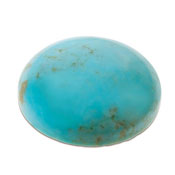Turquoise
(tur-koiz)
HISTORY and LORE
- Strongly associated with native cultures of the southwestern United States. For this reason turquoise is considered the most American gem of all. But there are other links too. Thousands of years ago, Egyptian kings and queens adorned themselves with turquoise, and Chinese emperors prized carvings made from it.
- Name comes from pierre turquoys, an old French term meaning “Turkish stone”. Turquoise from Persia (modern Iran) was once imported to Europe via Turkey.
- In ancient Persia, turquoise was thought to guarantee prosperity. For centuries Tibetans have believed turquoise brings health and good luck. To the Zuni of new Mexico turquoise is a traditional amulet against evil. And an old Apache tradition says if you journey to the end of a rainbow you’ll find turquoise.
- Birthstone for December and gem for the 11th wedding anniversary.
VALUE FACTORS
- Color: Light to medium-dark greenish blue to bluish green. Turquoise may show spangles caused by inclusions of the mineral pyrite (fool’s gold). Some also include remnants of matrix (the rock in which it formed). Matrix color can range from white to brown or black. “Spiderweb” turquoise has thin veins of matrix in attractive patterns. The most expensive turquois is a bright and uniform “sky” blue.
- Clarity: Always opaque.
- Cut: Cabochons, beads, carvings, inlays, and tablets.
- Size/Weight: All sizes are available. Occurs in pieces big enough for large carvings and other ornamental purposes. (Normally not priced or sold by carat weight.)
TREATMENT
- Commonly impregnated with oil, wax, or plastic to improve color and surface appearance. Plastic impregnation also improves toughness. Dyes or other color agents are sometimes used to darken matrix. Oil and wax eventually deteriorate, but plastic impregnation and matrix dyeing are normally permanent, and create no added special care requirement.
GEMOLOGY
Turquoise is classified as a mineral species. Turquoise has a complex chemical formula that includes aluminum, copper, hydrogen, oxygen, and phosphorous, plus water. Blue color is caused by copper, a key ingredient. Iron produces greenish tints.
CARE
Turquoise generally has good wearability.
- Hardness: Moderate scratch resistance. Rates 5 to 6 on the Mohs Hardness Scale.
- Toughness: Resistance to chipping and breaking is usually good to fair.
- Stability: Can be discolored by most household chemicals, including solvents, cleansers, alcohol, and cosmetics. Skin oils can also affect color.
- Cleaning: Remove smudges with a cotton swab or soft lint-free cloth. Detergent and water are usually safe for occasional cleaning, but no prolonged soaking or hard scrubbing. NEVER USE LIQUID CLEANER OR AN ULTRASONIC.
